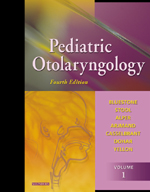SECTION I. CRANIOFACIAL GROWTH, DEVELOPMENT, AND MALFORMATIONS
Phylogenetic Aspects and Embryology
Postnatal Craniofacial Growth and Development
Genetics, Syndromology, and Craniofacial Anomalies
Malformations and Syndromes
Molecular Biology in Pediatric Otolaryngology
Principles and Methods of Management of Craniofacial
Malformations
Otolaryngic Manifestations of HIV Infection in Children
SECTION II. EAR AND RELATED STRUCTURES
Embryology and Developmental Anatomy of the Ear
Physical and Physiologic Bases of Hearing
Methods of Examination: Clinical Examination
Assessment of Hearing and Middle-Ear Function
Methods of Examination: Radiologic Aspects
Vestibular Evaluation
Otalgia
Otorrhea
Hearing Loss
Balance Disorders
Tinnitus
Facial Paralysis in Children
Congenital Anomalies of the Inner Ear
Surgical Correction of External and Middle Ear Anomalies
Congenital Anomalies of the Inner Ear
Perilymphatic Fistulas in Infants and Children
Diseases of the External Ear
Otitis Media and Eustachian Tube Dysfunction
Intratemporal Complications and Sequelae of Otitis Media
Intracranial Complications of Otitis Media and Mastoiditis
Diseases of the Inner Ear and Sensorineural Hearing Loss
Cochlear Implants
Diseases of the Labyrinthine Capsule
Injuries of the Ear and Temporal Bone
Tumors of the Ear and Temporal Bone
SECTION III. THE NOSE, PARANASAL SINUSES, FACE AND ORBIT
Embryology and Anatomy of the Paranasal Sinuses
Nasal Physiology
Methods of Examination
Imaging of the Paranasal Sinuses in Pediatric Patients with
Special Considerations for Endoscopic Surgery
Nasal Obstruction and Rhinorrhea
Epistaxis
Facial Pain and Headache
Orbital Swellings
Pediatric Plastic Surgery of the Head and Neck
Congenital Malformations of the Nose and Paranasal Sinuses
Rhinitis and Acute and Chronic Sinusitis
Chronic Sinusitis: Surgical Management
Complications of Nasal and Sinus Infections
Foreign Bodies of the Nose
Injuries of the Nose, Facial Bones, and Paranasal SInuses
Tumors of the Nose, Paranasal Sinuses, and Nasopharynx
Allergic Rhinitis
SECTION IV. THE MOUTH, PHARYNX, AND ESOPHAGUS
Embryology and Anatomy of the Mouth, Pharynx, and Esophagus
Physiology of the Mouth, Pharynx, and Esophagus
Methods of Examination
Sore Throat in Children: Diagnosis and Management
Dysphagia
Management of Drooling
Congenital Malformations of the Mouth and Pharynx
Primary Care of Infants and Children with Cleft Palate
Dental and Gingival Disorders
Orthodontic Problems in Children
Inflammatory Diseases of the Mouth and Pharynx
Tonsellectomy and Adenoidectomy
Obstructive Sleep Disorders
Oropharyngeal Manifestations of Systemic Disease
Idiopathic Conditions of the Mouth and Pharynx
Diseases of the Salivary Glands
Tumors of the Mouth and Pharynx
Congenital Malformations of the Esophagus
Functional Abnormalities of the Esophagus
Gastroesophageal Reflux
Burns and Acquired Strictures of the Esophagus
Foreign Bodies of the Pharynx and Esophagus
Injuries of the Mouth, Pharynx, and Esophagus
Neurologic Disorders of the Mouth, Pharynx, and Esophagus
SECTION V. THE LARYNX, TRACHEA, BRONCHI, AND LUNGS
Developmental Anatomy and Physiology of the Larynx and Trachea
Physiology of the Larynx, Airways, and Lungs
Methods of Examination
Cough
Aspiration
Hoarseness
Voice
Stridor and Airway Obstruction
Respiratory Disorders of the Newborn
Congenital Malformations of the Larynx
Congenital Malformations of the Trachea and Bronchi
Infections of the Lower Respiratory Tract
Noninfectious Disorders of the Lower Respiratory Tract
Neurogenic Diseases of the Larynx
Injuries of the Lower Respiratory Tract
Management and Prevention of Subglottic Stenosis
Foreign Bodies of the Larynx, Trachea, and Bro


